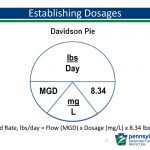One of the most common formulas used by water and wastewater operators is the pounds formula. This formula is used to determine the loading on the plant and its various process untis; the loading on the receiving water; the amount of chemical needed for a specific function. the formula can also be used to determine the amount of mixed liquor in the aeration basin and the amount of sludge to be disposed of in the landfill.
The formula assumes that all of the material found in wastewater weighs the same as water, 8.34 pounds per gallon.
The basic formula looks like this: Lbs = Flow, MGD X Conc, mg/L X 8.34 lbs/gal
Lbs = pounds
MG = Flow in Millions of Gallons per Day or Volume in Million Gallons
The Flow or Volume must be presented in Million Gallons, so you may have to convert from Gallons to Million Gallons to do the work properly.
Conc. = Concentration in mg/L or Concentration in ppm or Dosage in mg/L or ppm (these are the numbers usually supplied by laboratory analysis). PPM is an abbreviation for Parts per Million and that is the same as mg/L or (milligrams per liter).
Examples:
1. The flow is 250 gpm. What is the flow in MGD?
250 gpm X 1440 min/day = 360,000 gpd OR 250 gpm X 60 min/hour X 24 hrs/day = 360,000 gpd
(360,000 gpd) / (1,000,000) = 0.36 MGD
2. A water plant feeds alum at a dosage of 26 mg/L. The flow is 2.5 MGD. How many pounds of alum are used each day?
Flow, MGD X Conc, mg/L X 8.34 lbs/gal = lbs/day
2.5 MGD X 26 mg/L X 8.34 lbs/gal = 542 lbs/day
As you look at your formulas for F/M ratio, Sludge Age, etc. you will see that the formulas are made up of a pounds formula (also called Loading Formula) divided by a pounds formula. Such as:
F/M = (lbs BOD/day to aeration tank) / (lbs of MLVSS under aeration)
What tells me it is two loading formulas on top of each other is the LBS portion of the formula. I know that when I talk about finding pounds it is using the formula I just learned (Flow, MGD X Conc, mg/L X 8.34 lbs/gal)
* The top of this formula is talking about the FOOD available to the microorganisms and that food is going TO the aeration tank. So the FOOD is the TSS or SS leaving the primary clarifier or found in the plant influent and that number will be represented in mg/L (again, a number supplied by laboratory results). The FLOW is what is coming into the plant or or from the primary clarifier and will be presented as MGD. 8.34 is always there – it is my conversion, it is a constant.
* The bottom of this formula is talking about what is currently UNDER aeration (what is already in my aeration basin). So the MLVSS (Mixed Liquor Volatile Suspended Solids) is what we assume to be my bacteria (the Volatile portion of MLSS) and will be a number in mg/L the laboratory will supply. The FLOW is instead the VOLUME of my aeration basin, but is still presented in MG, not in gallons. Again, 8.34 is my conversion and is always there.
**One neat thing about mathematics – because there is an 8.34 lbs/gal on the top of this formula and one on the bottom of this formula – they cancel each other out and you don’t have to do those two extra steps and you will get the same answer.
So your formula will look like this:
F/M Ratio = (Flow, MGD X TSS, mg/L X 8.34 lbs/gal) / (Aerator Vol, MG X MLVSS, mg/L X 8.34 lbs/gal)
but to work it: (Flow, MGD X TSS, mg/L) / (Aerator Vol, MG X MLVSS, mg/L)
Practice Problems:
1. How many pounds of 100% gas chlorine are needed to disinfect a flow of 85,000 gpd at 12 mg/L?
2. The suspended solids in a stream are measured at 360 mg/L. The stream flow is estimated at 3.2 MGD. How many pounds of solids are carried by the stream each day?
3. The backwash water of a plant contains 320 mg/L of solids. 4,000 gallons of water are used for backwash. How many pounds of solids are deposited in the backwash lagoon with each backwash?
4. A 400,000 gallon storage tank is to be disinfected with 50 mg/L of chlorine. How many pounds of gas chlorine would it take to disinfect this tank?
5. How many pounds of calcium hypochlorite at 67% is needed to disinfect 125,000 gallons per day flow with a dosage of 8 mg/L?
Answers:
1. 0.085 MGD X 12 mg/L X 8.34 lbs/gal = 8.5 lbs
2. 3.2 MGD X 360 mg/L X 8.34 lbs/gal = 9,608 lbs
3. (4,000 gal) / (1,000,000) = 0.004 MGD X 320 mg/L X 8.34 lbs/gal = 10.7 pounds
4. (400,000 gal) / (1,000,000) = 0.4 MGD X 50 mg/L X 8.34 lbs/gal = 166.8 lbs
5. (125,000 gal) / (1,000,000) = 0.125 MGD X 8 mg/L X 8.34 lbs/gal = 8.34 lbs at 100 %
(8.34 lbs) / (67 %), but we don’t use % – change % to a decimal, so
(8.34 lbs) / (0.67) = 12.45 lbs
Many of you are used to using the Davidson Pie Chart for this and it looks like this:

